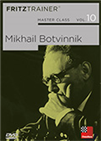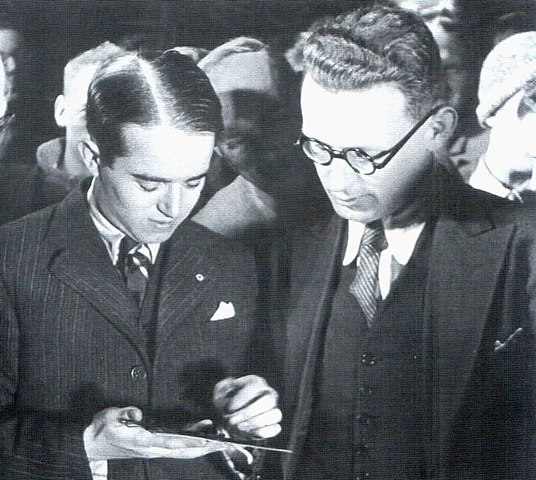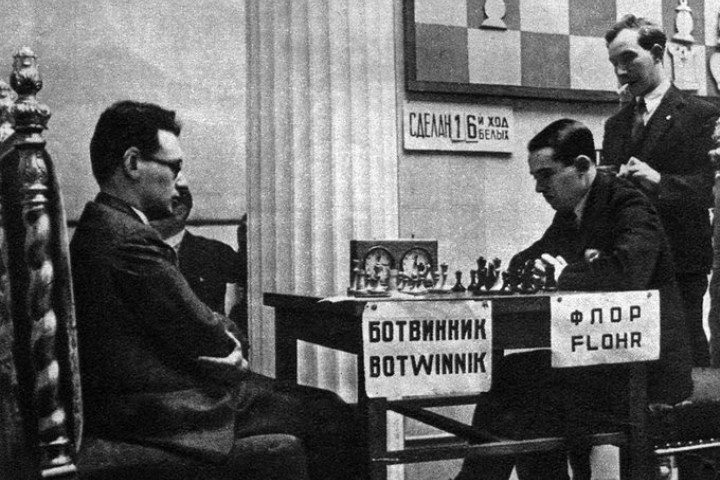 A young Mikhail Botvinnik was playing one of the top players at the time, Salo Flohr from Czechoslovakia. The latter was considered the favourite. Flohr won the first game with black, and outplayed Botvinnik in game six with the white pieces. In his book “How to Play Chess Endings”, Eugène Znosko-Borovsky says that the game contained an extremely instructive ending, which well demonstrates the concentrated power of the two bishops, and the helplessness of the two knights against them — they move in various directions on the board, without any coordination.
A young Mikhail Botvinnik was playing one of the top players at the time, Salo Flohr from Czechoslovakia. The latter was considered the favourite. Flohr won the first game with black, and outplayed Botvinnik in game six with the white pieces. In his book “How to Play Chess Endings”, Eugène Znosko-Borovsky says that the game contained an extremely instructive ending, which well demonstrates the concentrated power of the two bishops, and the helplessness of the two knights against them — they move in various directions on the board, without any coordination.
We described the background of the match in our previous article. But was the position winning for white all along? We asked our readers to send their analyses, so we could settle the question.
It turned out the handling of the ending was indeed extremely instructive.
This time no mistake was made. Flohr’s bishops were always winning. But the analyses now are much deeper than in the old sources.
 Our experts show, using the games of Botvinnik, how to employ specific openings successfully, which model strategies are present in specific structures, how to find tactical solutions and rules for how to bring endings to a successful conclusion
Our experts show, using the games of Botvinnik, how to employ specific openings successfully, which model strategies are present in specific structures, how to find tactical solutions and rules for how to bring endings to a successful conclusionBut here the general intuition that the bishops must be winning proved correct. They are indeed a powerful endgame weapon!
This endgame is indeed a masterpiece for the conversion of the advantage of the pair of bishops. At first Charles Sullivan had some doubts, but then Zoran Petronijevic proved that the bishops always win. And then Albert Silver announced that he has created a new neural network engine, which is especially trained in endgames. I of course immediately asked Albert to check this riddle and here comes his answer, which confirms Zoran's analysis:
 Hi Karsten,
Hi Karsten,
I ran this through the new neural network and giving it a lot of time and a lot of resources, and the eval has only been rising for White after 41. f6 (I have not analyzed to see if f6 was a mistake, so if I should, please tell me). This is still an early net as you know, but so far its endgame skills have proven exceptional, so hopefully it is not very wrong if indeed it is. ;-)
Although it flip-flops between Ke2 and Kf3 for a bit at first, it decisively selects Kf3 after 1:02 with a modest evaluation of +1.04. After over a full hour of analysis, and 65 billion nodes, the evaluation climbs to over +3, leading me to believe that after Botvinnik’s 41...f6, the game is winning for Flohr. As I mentioned before, if this is correct, but 41...f6 was the losing move, I cannot say. The mainline after 41...f6 changes a few times, so I am sending the lines it displayed as it attempted different answers for Black.
So I asked Albert to check if the position is lost anyway, and indeed it is:
I see no evidence that any other move 41 by Botvinnik would have saved it. The obvious alternative 41.Nef6 is no better.

Flohr and Botvinnik
Finally as usual comes Zoran Petronijevic’s solution:
In our replay board above there are a large number of functions you can use to really understand the game and the analysis. Recently we published a comprehensive tutorial plus video instructions which tells you about all the powerful features and buttons that make the ChessBase's replay one of the best replay experiences around.
One big advantage is that you can start an engine (fan icon) that will help you to analyse. You can get multiple lines of analysis by clicking the + button to the right of the engine analysis window. The "!" key, incidentally, shows you the threat in any position, which is incredibly useful in the case of unclear moves.
 There is one more thing you can do. It is a lot of fun, but also a serious challenge: Click on the rook icon below the notation window. This will allow you the play the above position against Fritz, at your level of playing strength (e.g. "Club Player"), right here on the news page. Note that your analysis, in which you can delete, move or promote lines, is stored in the notation as new variations. In the end you will find the game with your analysis in the cloud. So nothing is ever lost.
There is one more thing you can do. It is a lot of fun, but also a serious challenge: Click on the rook icon below the notation window. This will allow you the play the above position against Fritz, at your level of playing strength (e.g. "Club Player"), right here on the news page. Note that your analysis, in which you can delete, move or promote lines, is stored in the notation as new variations. In the end you will find the game with your analysis in the cloud. So nothing is ever lost.
Links


















 A young Mikhail Botvinnik was playing one of the top players at the time, Salo Flohr from Czechoslovakia. The latter was considered the favourite. Flohr won the first game with black, and outplayed Botvinnik in game six with the white pieces. In his book “How to Play Chess Endings”, Eugène Znosko-Borovsky says that the game contained an extremely instructive ending, which well demonstrates the concentrated power of the two bishops, and the helplessness of the two knights against them — they move in various directions on the board, without any coordination.
A young Mikhail Botvinnik was playing one of the top players at the time, Salo Flohr from Czechoslovakia. The latter was considered the favourite. Flohr won the first game with black, and outplayed Botvinnik in game six with the white pieces. In his book “How to Play Chess Endings”, Eugène Znosko-Borovsky says that the game contained an extremely instructive ending, which well demonstrates the concentrated power of the two bishops, and the helplessness of the two knights against them — they move in various directions on the board, without any coordination.  Hi Karsten,
Hi Karsten,
 There is one more thing you can do. It is a lot of fun, but also a serious challenge: Click on the rook icon below the notation window. This will allow you the play the above position against Fritz, at your level of playing strength (e.g. "Club Player"), right here on the news page. Note that your analysis, in which you can delete, move or promote lines, is stored in the notation as new variations. In the end you will find the game with your analysis in the cloud. So nothing is ever lost.
There is one more thing you can do. It is a lot of fun, but also a serious challenge: Click on the rook icon below the notation window. This will allow you the play the above position against Fritz, at your level of playing strength (e.g. "Club Player"), right here on the news page. Note that your analysis, in which you can delete, move or promote lines, is stored in the notation as new variations. In the end you will find the game with your analysis in the cloud. So nothing is ever lost.




